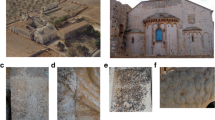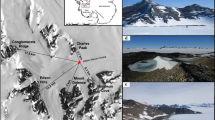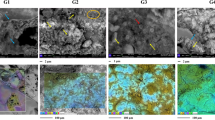Abstract
Next Generation Sequencing (NGS), using the Illumina® metabarcoding system, showed differences between biofilm communities on three degraded siliceous stone church façades in central Rio de Janeiro. Two church biofilms (on granite and augen gneiss) were dominated by Actinobacteria; the third (granite), surrounded by trees and further from intense vehicular traffic, by Gammaproteobacteria. Yeast-like forms of Basidiomycetes and Ascomycetes were major fungi on all facades, but 22.8% of Operational Taxonomic Units could not be assigned to any fungal taxon after DNA amplification with ITS primers and analysis with the UNITE database, indicating the need for more fungal NGS studies. The pipeline used in analysis of the V4 region of rRNA bacterial gene sequences influenced the taxa detected, with two major classes and many genera identified only by the pipeline using the Greengenes, and not the Silva, database. Principal Components Analysis separated façade biofilms into the appropriate three groups and indicated greater dissimilarity of the tree-surrounded church biofilm from the others, confirmed by Jaccard Similarity coefficients, suggesting that local environment influences community composition more than stone type. NGS allows rapid and detailed analysis of microbiomes, but results must be carefully assessed and must not be used as the sole indication of community composition.
Similar content being viewed by others
Avoid common mistakes on your manuscript.
Introduction
The Next Generation Sequencing (NGS) techniques developed in this century are being increasingly used in various environments for microbial ecology studies. They provide fast, efficient and low cost DNA sequencing compared with standard and traditional methods. The software tools available for assembly, elimination of chimaeras and quantitative analysis are constantly improving, allowing rapid (though memory-consuming) processing of sequences. The collection of software applications used to process a DNA data set is called the pipeline and is often developed “in house” for analysis of specific environments (see, for example, [10] and references therein). The use of this technology for the study of microbial communities directly in their natural habitats (metagenomics) has only recently spread to the field of biodeterioration [e.g., 12, 21]. Previous investigations have used traditional microbiological methods to identify organisms involved in discoloration [e.g., 8, 16] and degradation [e.g., 5] of historic and culturally important buildings and Gaylarde and Gaylarde [6] have discussed the microorganisms involved in biofilm formation on siliceous stone buildings in Latin America. For a review written prior to the introduction of NGS techniques into this area, see [19].
We have applied NGS methods, along with more traditional techniques, to study the microbial communities in biofilms on degrading stone buildings of historic and cultural importance, using siliceous stone façades of churches in the city of Rio de Janeiro, Brazil, as study sites [7, 9] and found some problems resulting from the analysis of the NGS results. This led us to carry out a more detailed comparison of the methods employed in such studies.
Materials and Methods
Sampling
Samples were obtained from the front façades of three churches in the centre of the city of Rio de Janeiro, Brazil: Nossa Senhora do Monte do Carmo (CA), situated on Praca XV de Novembro, São Francisco de Paula (SF), in the Largo de São Francisco de Paula, and Nossa Senhora da Candelária (C), located in Pio X Square. The façade blocks are composed, respectively, of granite, granite and augen gneiss. Churches C and CA are subject to higher levels of air pollution from passing traffic than SF, which is located in the middle of a leafy square. Specimens were taken randomly from obviously colonized areas at a height of 1–2 m, using the adhesive tape technique [20] and by collecting samples of contour scales composed of dark surface crust and underlying stone. Approximately 15 samples were taken from each church and were used in a variety of chemical and microbiological analyses.
Chemical and Microbiological Analyses
These were carried out as previously reported [9]. Water-soluble salts were quantified by standard chemical methods and SEM was used to detect both salt crystals and microbial cells in the samples. DNA was extracted from duplicate ground stone samples and subjected to amplification with bacterial and fungal primers, followed by NGS using the Illumina® technique. Adhesive tape and ground stone samples were also examined using the light microscope to detect microbial cells. Adhesive tape samples were not used for either SEM or DNA analyses, but were easily examined by light microscopy.
Data Analysis
DNA sequences were analysed by 3 different pipelines, involving software packages and the Greengenes (pipeline 1) and Silva (pipeline 2) databases for bacteria and the UNITE database for fungi; details can be found in [9] and [3]. Raw data files were deposited in the NCBI Sequence Read Archive (SRA) with accession number SRP076760.
Statistical Analysis
Classes and genera of bacteria and fungi, determined as Operational Taxonomic Units (OTUs), were subjected to Principal Components Analysis (PCA), with two or three components. Similarity levels between the three communities were also determined using the Jaccard Similarity Index (Sj), where:
Sj = Total number of shared taxa ÷ (number of shared taxa + number of unique taxa in Sample a + number of unique taxa in Sample b….etc.). A similarity index of unity means that the populations are the same.
Results and Discussion
Light microscopy of adhesive tape samples indicated the heterogeneous nature of the biofilms, a fact that is well known and has been pointed out as a relevant factor in the design of sampling techniques for traditional analyses of building stone [4].
Pipelines and Results for Bacterial Analyses
Both pipelines used for bacterial DNA analysis indicated that Actinobacteria were major components of the C and CA biofilms, but that Gammaproteobacteria were the principal members of the SF biofilm (Figs. 1, 2). There were differences, however, between the taxa detected by the two pipelines. Pipeline 2 detected a higher proportion of Epsilonproteobacteria; pipeline 1 of the Firmicutes class Clostridia, and of Deinococci, Cyanobacteria, Sphingobacteriia and Armatimonadetes. Different classes of Bacteroides were detected by the 2 pipelines, but the two predominant classes, Flavobacteria and Cytophagia, were detected by both. Both pipelines allowed the detection of many halophilic bacterial taxa, Salinicoccus, Oceanospirillales, Halobacteriaceae (Archaea), Salinimicrobium, Kocuria, Cellulomonas and Halococcus, while pipeline 1 only showed OTUs belonging to the halophilic genera Salinicola, Marinobacter and Halobacillus; in correlation, the chemical analyses indicated high levels of sodium chloride and calcium sulphate in the samples.
NGS analysis using Pipeline 1, with the Greengenes database, showing main bacterial classes detected in the biofilm community on the three church façades. Groups below 0.2% are not included. SF church of São Francisco de Paula; CA church of Nossa Senhora do Monte do Carmo; C church of Nossa Senhora da Candelária
NGS analysis using Pipeline 2, with the Silva database, showing main bacterial classes detected in the biofilm community on the three church façades. Groups below 0.2% are not included. SF church of São Francisco de Paula; CA church of Nossa Senhora do Monte do Carmo; C church of Nossa Senhora da Candelária
Coccoid cyanobacteria, tentatively identified as Chroococcidiopsis, were seen in light microscopy examinations of the tape strips and crushed stone samples and filamentous cyanobacteria were detected by SEM in several samples; some were seen penetrating into the stone, becoming endolithic in nature. Neogypsum-encased filamentous cyanobacteria were also seen, confirmed by EDX, indicating the mobilization and reprecipitation of salts from within the stone onto the cell surfaces, leading to degradation [9]. The proportion of cyanobacterial OTUs in the three duplicate samples was, however, low. Using Pipeline 1 and 2 respectively, the proportions were 0.015 and 0.01% for C, 0.02 and 0.025% for CA and 0.065 and 0.04% for SF, the major genus identified being the coccoid Chroococcidiopsis. It is possible that these figures might have been increased by the use of specific cyanobacterial primers in the PCR, but Brandes et al. [2] stated that many cyanobacterial morphotypes have never been subjected to molecular analysis and their sequences are thus not present in the databases. The failure of databases to detect many members of a microbial community has also been emphasized by Abad et al. [1]. The present results emphasize that NGS techniques should not be used in isolation from other microbiological analyses.
A number of as yet uncultured bacteria were detected by the NGS technology. These included members of the Acidobacteria, Actinobacteria, Bacteroidetes, Chloroflexi, Cyanobacteria, Firmicutes, Gemmatimonadetes, alpha- and gamma-proteobacteria. The Chloroflexi phylum was especially notable for its high proportion in C (12.1%, compared with 3.18% for CA and 3.76% for SF). All of these were identified by pipeline 2 as belonging to the class Thermomicrobia, which contains thermotolerant or thermophilic bacteria, some of which have been isolated in culture [14 and references therein]. Pipeline 1 also identified high levels of this class (12.03% in C, 3.28% in CA and 3.76% in SF), but in addition allowed the detection of 0.04% OTUs of the uncultured organism TK10 (class Chloroflexi) in sample C. Problems of detection may sometimes be resolved by using alternative primers [17], but the importance of the pipeline used in DNA sequencing data analysis is emphasized by the present results.
Fungal Analysis
The fungal DNA sequences, analysed only by one pipeline and the UNITE database, indicated the presence of ascomycetes and basidiomycetes, with few other groups (Fig. 3). Few fungal filaments were seen by either light microscopy or SEM and so the detection of these 2 groups by NGS suggests that the organisms were present mainly in their yeast-like form. Fungi known to be involved in stone degradation [13], the microcolonial rock-inhabiting black fungi (members of the dothidiomycetes), were detected at almost 1% OTUs. This group is difficult to culture, requiring long incubation periods on laboratory media [11], suggesting that molecular methods would have a particular advantage in their detection. However, this is also a group whose molecular biology has been relatively little studied. Insufficient DNA sequences are available in the databases [18] and, indeed, these organisms may account for a considerable proportion of the OTUs (22.8% on average) that were identified in the current NGS analyses merely as “fungi”, with further identification impossible.
Similarity Analyses
PCA plots, using both 2 and 3 components, placed the 6 samples into their appropriate 3 groups, although pipeline 2 produced more compact groups (Fig. 4 shows the 3-component analyses only). It appeared that the SF bacterial community was more different from C and CA than those two were from one another and this was confirmed by the Jaccard similarity indices. For C vs CA, Sj was 0.46, for C + CA vs SF, 0.21. This pattern was repeated for the fungal communities, where the Sj value for C + CA vs SF was 0.14, indicating an even greater difference.
A closer examination of the bacterial and fungal communities for the various sites suggested why that on the façade of SF might differ from the others. This biofilm contained fungal genera that are associated with trees and insects, which might be expected to occur in the leafy environs of the Largo de São Francisco de Paula. These included Acremonium, Hirsutella, Rhodotorula, Colletotrichum, Sporobolomyces and Khuskia (the anamorph of Nigrospora), none of which were detected in the C and CA samples. In addition, the SF biofilm contained higher levels of cyanobacteria and fewer thermophilic bacteria such as the Actinobacteria order Thermoleophilia (0.425 and 0.96% average OTUs for C and CA, 0.06 and 0.06% for SF, using pipeline 1 and 2, respectively). Once again, this can be linked to the local environment, with vegetation providing a source of Cyanobacteria and protection from the intense sunlight and associated UV and high temperature in the sub-tropical climate of Rio de Janeiro.
Conclusions
NGS techniques are easy, rapid and relatively cheap. They can detect uncultivated, or hard-to-cultivate, microorganisms without the need for more exigent techniques such as FISH, and will doubtless lead to a vast increase in our knowledge of the microbial communities present in cases of biodeterioration. Newly developing technologies, such as micro-metabolomics, will enable us to correlate presence of microorganisms with their activities at a cellular level, the “holy grail” of biodeterioration. In these early days, however, it is important to realize the problems associated with NGS methods. Here, we have highlighted the variations in results from using different pipeline analyses and the problems involved in identifying organisms with insufficient sequences deposited in databases, as well as pointing out the necessity for the use of a variety of microbiological techniques in addition to DNA analysis. Primer size and bias is also a factor that may result in a high ratio of uncultured microorganisms. Another potential trap is the existence of extracellular DNA (e-DNA), which may persist after release from either living or dead microbial cells that may no longer be present in the biofilm [15]. Such DNA is no longer subject to intracellular homeostasis and DNA repair enzymes and maybe altered to produce a sequence that is recognized as a different organism, or as an uncultured, or unknown, organism. It is essential that other techniques be used together with NGS analysis, when the latter is employed to determine the members of a microbial community.
References
Abad D, Albaina A, Aguirre M, Laza-Martinez A, Uriarte I, Iriarte A, Villate F, Estonba A (2016) Is metabarcoding suitable for estuarine plankton monitoring? A comparative study with microscopy. Mar Bio 163:149. doi:10.1007/s00227-016-2920-0
Brandes M, Albach DC, Vogt JC, Mayland-Quellhors E, Mendieta-Leiva G, Golubic S, Palinska KA (2015) Supratidal extremophiles. Cyanobacterial diversity in the rock pools of the Croatian Adria. Microb Ecol 70:876–888
Celikkol-Aydin S, Gaylarde CC, Lee T, Melchers RE, Witt DE, Beech IB (2016) 16S rRNA gene profiling of planktonic and biofilm microbial populations in the Gulf of Guinea using Illumina NGS. Mar Environ Res 122:105–112
Cutler NA, Chaput DL, Oliver AE, Viles HA (2015) The spatial organisation and microbial community structure of an epilithic biofilm. FEMS Microbiol Ecol 91:1–9
De los Rios A, Ascaso C (2005) Contributions of in situ microscopy to the current understanding of stone biodeterioration. Int Microbiol 8:181–188
Gaylarde P, Gaylarde C (2004) Deterioration of siliceous stone monuments in Latin America: microorganisms and mechanisms. Corros Rev 22:395–415
Gaylarde C, Baptista-Neto JA, Ogawa A, Kowalski M, Celikkol-Aydin S, Beech I (2017) Epilithic and endolithic microorganisms and deterioration on stone church facades subject to urban pollution in a sub-tropical climate. Biofouling 33:113–127. doi:10.1080/08927014.2016.1269893
Gaylarde CC, Rodríguez CH, Navarro-Noya YE, Ortega-Morales BO (2012) Microbial biofilms on the sandstone monuments of the Angkor Wat Complex, Cambodia. Curr Microbiol 64:85–92
Gaylarde C, Ogawa A, Beech I, Kowalski M, Baptista-Neto JA (2017) Analysis of dark crusts on the church of Nossa Senhora do Carmo in Rio de Janeiro, Brazil, using chemical, microscope and metabarcoding microbial identification techniques. Inter Biodet Biodeg 117:60–67
Golosova O, Henderson R, Vaskin Y, Gabrielian A, Grekhov G, Nagarajan V, Oler AJ, Quiñones M, Hurt D, Fursov M, Huyen Y (2014) Unipro UGENE NGS pipelines and components for variant calling, RNA-seq and ChIP-seq data analyses. Peer J 2:e644. doi:10.7717/peerj.644
Gorbushina AA, Kotlova ER, Sherstneva OA (2008) Cellular responses of microcolonial rock fungi to long-term desiccation and subsequent rehydration. Stud Mycol 61:91–97
Gutarowska B, Celikkol-Aydin S, Bonifay V, Otlewska A, Aydin E, Oldham AL, Brauer JI, Duncan KE, Adamiak J, Sunner JA, Beech IB (2015) Metabolomic and high-throughput sequencing analysis—modern approach for the assessment of biodeterioration of materials from historic buildings. Front Microbiol 6:979. doi:10.3389/fmicb.2015.00979
Hoppert M, Flies C, Pohl W, Günzel B, Schneider J (2004) Colonization strategies of lithobiontic microorganisms on carbonate rocks. Environ Geol 46:421–428
Houghton KM, Morgan XC, Lagutin K, MacKenzie AD, Vyssotskii M, Mitchell KA, McDonald IR, Morgan HW, Power JF, Moreau JW, Hanssen E, Stott MB (2015) Thermorudis pharmacophila WKT50.2T sp. nov., a novel isolate of class Thermomicrobia isolated from geothermal soil, and emended descriptions of Thermomicrobium roseum, Thermomicrobium carboxidum, Thermorudis peleae and Sphaerobacter thermophilus. Int J Syst Evol Microbiol 65:4479–4487. doi:10.1099/ijsem.0.000598
Okshevsky M, Regina VR, Meyer RL (2015) Extracellular DNA as a target for biofilm control. Curr Opin Biotechnol 33:73–80
Ortega-Morales BO, Gaylarde C, Anaya-Hernandez A, Chan-Bacab MJ, De la Rosa-García SC, Arano-Recio D, Montero-M J (2013) Orientation affects Trentepohlia- dominated biofilms on Mayan monuments of the Rio Bec style. Inter Biodet Biodeg 84:351–356
Pan W, Byrne-Smith M, Wang C, Lu S, Clemmons S, Zahorchak RJ, Han J (2014) Dna polymerase efficiency preference determines PCR priming efficiency. BMC Biotechnol 14:10
Ruibal C, Platas G, Bills GF (2005) Isolation and characterization of melanised fungi from limestone formations in Mallorca. Mycol Prog 4:23–28
Scheerer S, Ortega-Morales O, Gaylarde C (2009) Microbial deterioration of stone monuments—an updated overview. Adv Appl Microbiol 66:97–139
Shirakawa MA, Gaylarde CC, Gaylarde PM, John V, Gambale V (2002) Fungal colonization and succession on newly painted buildings and the effect of biocide. FEMS Microbiol Ecol 39:165–173
Vázquez-Nion D, Rodríguez-Castro J, López-Rodríguez MC, Fernández-Silva I, Prieto B (2016) Subaerial biofilms on granitic historic buildings: microbial diversity and development of phototrophic multi-species cultures. Biofouling 32:657–669
Author information
Authors and Affiliations
Corresponding author
Rights and permissions
About this article
Cite this article
Ogawa, A., Celikkol-Aydin, S., Gaylarde, C. et al. Microbiomes of Biofilms on Decorative Siliceous Stone: Drawbacks and Advantages of Next Generation Sequencing. Curr Microbiol 74, 848–853 (2017). https://doi.org/10.1007/s00284-017-1257-3
Received:
Accepted:
Published:
Issue Date:
DOI: https://doi.org/10.1007/s00284-017-1257-3








